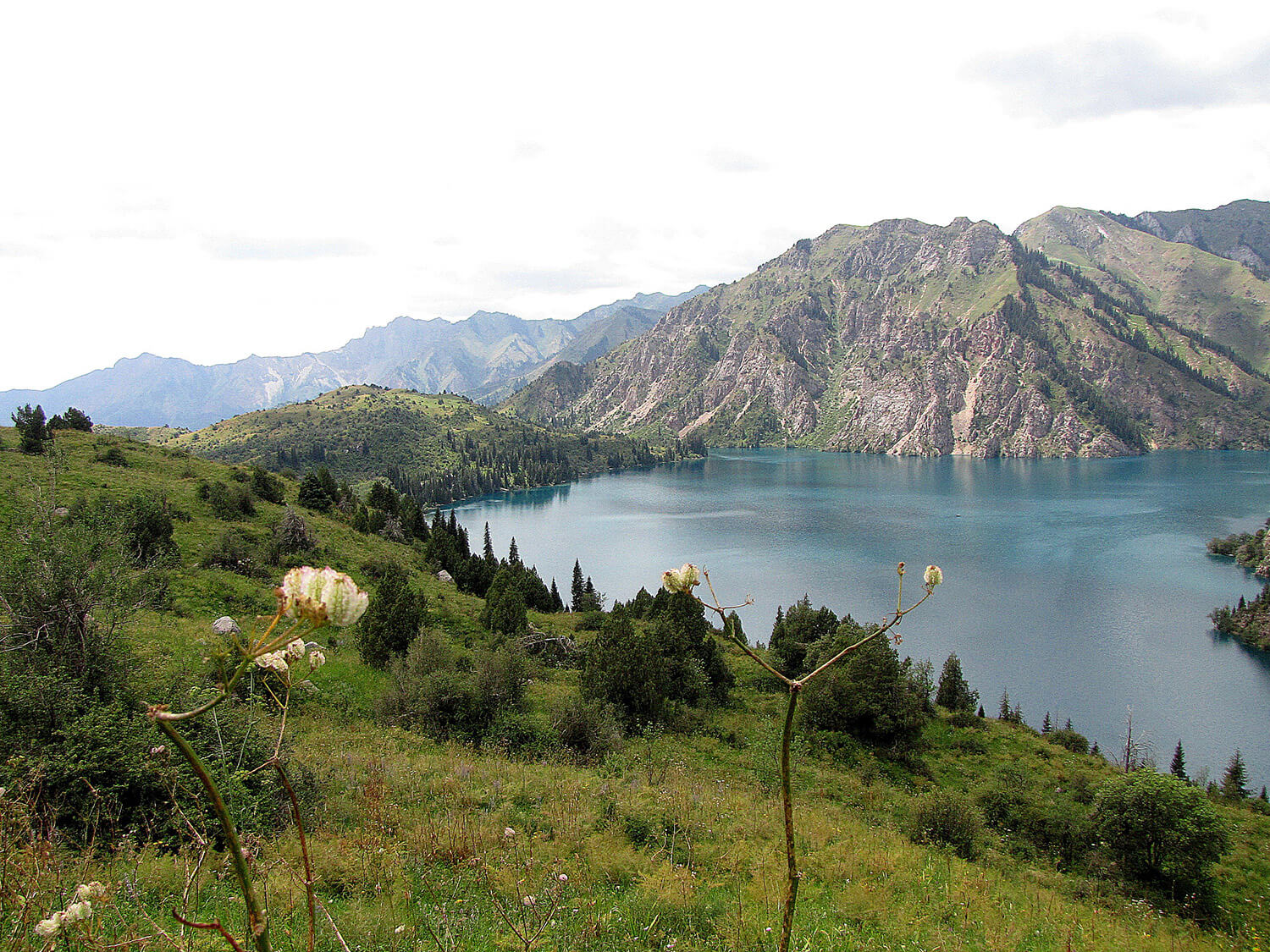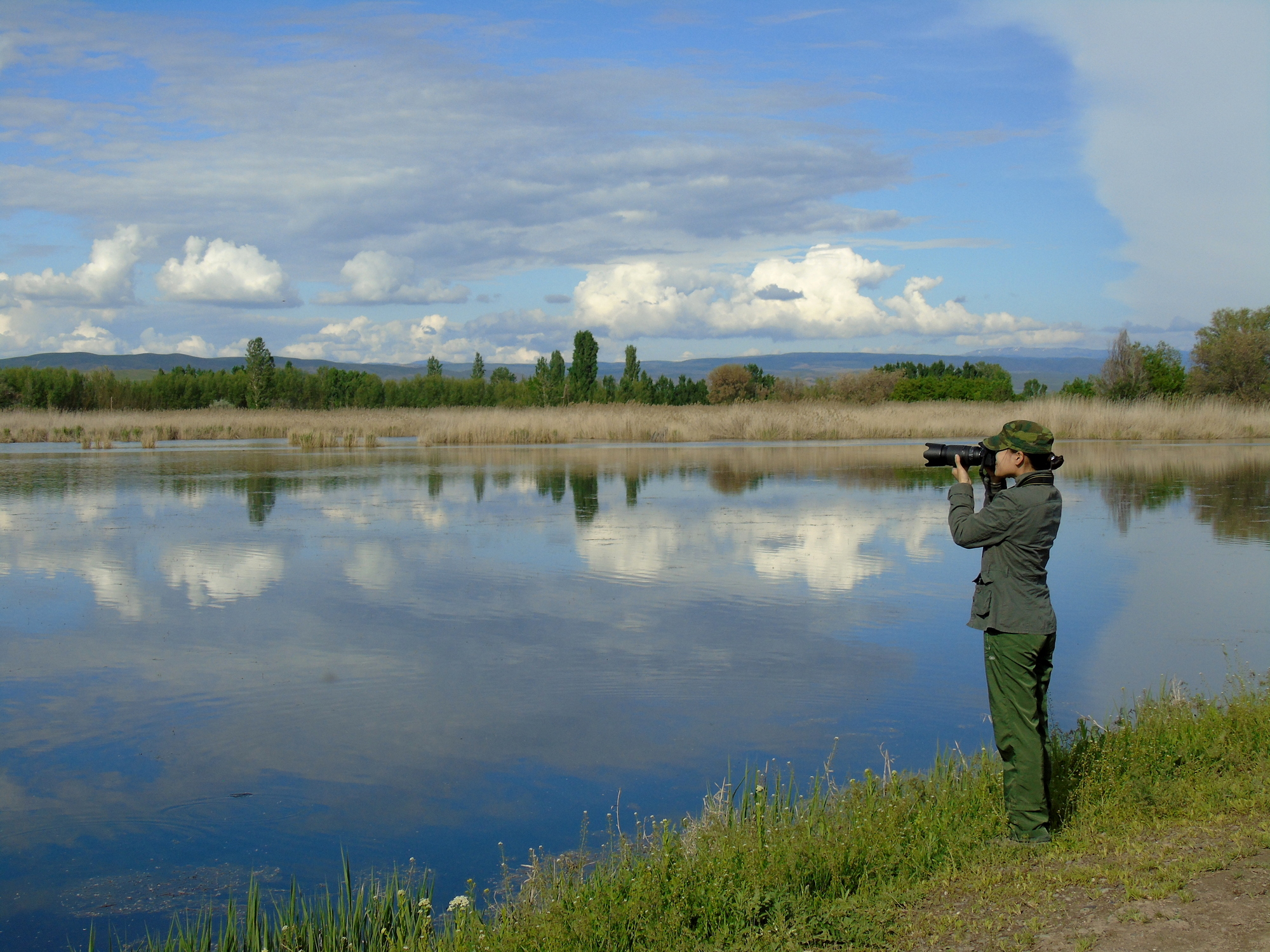Наблюдение за птицами в знаменитых заповедниках Кыргызстана Наблюдение за птицами в биосферных заповедниках доставляет большое удовольствие, так как здесь есть большая возможность увидеть много различных видов птиц. Заповедники Сары-Челек и Арсланбоб являются всемирно известными уникальными биосферными территориями в Центральной Азии. Сары-Челекский биосферный заповедник — это особо охраняемая природная территория Киргизии, расположенная между Чаткальским и Ат-Ойнокским хребтами. Это наиболее увлажнённые места, как в Кыргызстане, так и в Центральной Азии. Здесь мягкий умеренный климат и изобилие разнообразной растительности. Заповедник создан в 1959 г. В 1979 году заповедник был включен в международную сеть биосферных заповедников ЮНЕСКО. Основным ландшафтным элементом заповедника является озеро Сары-Челек. Озеро с чистой пресной водой занимает площадь около 5 кв. км и имеет максимальную глубину 246 м. В окрестностях главного озера, существует ещё 6 мелких озер. Во всех озёрах температура воды разная. Возможно, это обстоятельство создаёт и разные естественные условия для фауны, обитающей около Сары-Челекских озёр. Климат теплый летом и малоснежный зимой. Значительную часть заповедника занимают ореховые, яблоневые и грушевые леса. Из редкой фауны здесь обитают ондатра, благородный олень, лань, дикобраз, куница, архар, кабаны, козерог, а также 157 различных видов птиц. Заповедник Сары-Челек – это уникальное природное наследие Центральной Азии.
Арсланбобский заповедник – Единственный в мире Ореховый рай. Расположен на юго-западных склонах Ферганского хребта. Это также одна из самых увлажнённых зон Кыргызстана и Центральной Азии. Здесь выпадет наибольшее количество атмосферных осадков. Этому способствует Ферганский хребет, который служит преградой на пути северо-западных влажных воздушных течений. Горный хребет выполняет роль аккумулятора влаги. Географическое положение и природные факторы обусловили здесь условия для крупнейшего в мире орехового леса. До сих пор учёные спорят о возрасте этих ореховых лесов. Ореховые леса составляют отдельный оазис представляющий реликт лиственных лесов третичного периода. Но третичный период имеет большой интервал геологической истории. Он начинается от вымирания динозавров в мел-палеогеновое время и заканчивается до начала последнего ледникового периода, около 1,8 млн. лет назад. За это время климат на земле испытал значительные изменения, при этом ореховые леса Арсланбоба являются свидетелями этих глобальных изменений. Кокой же возраст имеют ореховые леса Арсланбоба? На этот и другие вопросы мы ответим в нашей полевой поездке. В Арсланбобе обитают многие виды птиц, которых мы попытаемся увидеть. Национальный парк Кыргыз-Ата. Большая часть территории парка представляет ботанический заповедник, созданный для сохранения арчовых лесов, горных тюльпанов и шафрана. В основном здесь растёт Зеравшанская и Туркестанская виды арчи, из животного мира здесь обитает более 200 видов животных. Здесь можно увидеть – снежного барса, рыся, волков, зайцев и лисиц. Продолжительность поездки 12 дней. Продолжительность тура можно изменить по желанию участников. Общая протяжённость маршрута – около 700 км. Программа является гибкой. Вы можете изменить продолжительность поездки. Маршрут поездки пересекает Северный Тянь-Шань, Западный Тянь-Шань и Южный Тянь-Шань. Мы увидим как меняется высотная зональность, природные ландшафты, климат, флора, фауна, а также культура людей. Наиболее благоприятное время для поездки – апрель – май, сентябрь-октябрь. В это время мы можем посмотреть весеннюю и осеннею миграции птиц.
Фото некоторых птиц Кыргызстана

ПРОГРАММА
Встреча в аэропорту. Брифинг – знакомство с программой и местным экспертом-гидом. Лекция о заповедниках и птицах Кыргызстан. Ночь в гостинице.
В течение 4-5 часов мы поднимемся в субальпийский высотный пояс. На высоте около 2300 м расположена долина Сусамыр. Здесь находятся альпийские луга и множество кочевых летних стоянок. Затем мы начнём спуск в зону горных лесов. Здесь расположено красивое озеро Саз-Кёл окружённое древесным лесом и различными кустарниками. Озеро Саз-Кёл в летний период становятся местом для жизни местных кочевников. Местные люди устанавливают здесь юрты, пасут скот и делают молочные продукты. Многие собирают дикие ягоды, которых здесь в изобилии. Здесь прекрасное и почти дикое место для полевого лагеря и наблюдения за птицами. Кроме орнитологов, это ущелье привлекает биологов, любителей флоры и фауны. Горный обвал, произошедший здесь несколько тысяч лет назад, перекрыл ущелье, создав условия для образования озера Итагар. Наблюдение за птицами, Location 1. Размещение в палатках.
Экскурсия по ущелью Итагар и наблюдение за птицами, Location 2. Сегодня мы попадём в широкую долину расположенную вверх по ущелью. Здесь, на слиянии рек в густых зарослях кустарников и елей можно увидеть различных птиц. Птицы также гнездятся у озера Саз-Кёль. Возвращение в лагерь. Ночь в палатках.
По пути мы планируем сделать остановку на обед на берегу Токтогульского водохранилища – самого большого искусственного водоёма в Центральной Азии, который был построен как резервуар для Токтогульской гидроэлектростанции, Location 3. Здесь можно увидеть редких птиц: Бoрoдaч (Gypaetus barbatus); Журавль-красавка (Demoiselle - Crane) (Anthropoides virgo); Серая неясыть (Tawny Owl) (Strix aluco). Здесь можно встретить очень редкий вид - Eastern Imperial Eagle (Aquila heliaca). Далее, двигаясь на юг, мы попадаем в пустынно-степной пояс восточной части Ферганской долины. Здесь обитают некоторые виды полупустынных птиц. Затем мы снова поднимемся в горно-лесной пояс в окрестностях озера Сары-Челек. Экскурсия в окрестностях озёр. Выбор удобно места для наблюдения за птицами. Ночь в гостевом доме.
Заповедник Сары-Челек это место где можно провести увлекательное и романтическое наблюдение за птицами. Можно увидеть, как птицы делают гнёзда, гнездятся, находят пищу, кормят потомство, Location 4. Лучшими фотокадрами могут стать фотографии во время их брачного периода. Здесь можно увидеть редкие виды птиц: Red-necked Grebe (Podiceps auritus), Cormorant (Phalacrocorax carbo), Gray heron (Ardea cinerea), Pintail (Anas acuta), Merganser big (Mergus merganser). Терпеливые наблюдатели за птицами, могут увидеть охоту Osprey (Pandion haliaetus) которая охотится на рыбу. А также можно увидеть охоту Goshawk (Accipiter gentilis). Здесь также можно наблюдать за White-tailed Eagle (Haliaeetus albicilla), Falcon Peregrine Falcon (Falco peregrinus), Checkpoint (Falco subbuteo), Saker (Falco cherrug). Вблизи озёр можно увидеть Coot (Fulica atra), Anthropoides virgo, Lapwing (Vanellus vanellus), Yellow-headed Wagtail (Motacilla citreola) и другие птицы. В Сары-Челеке очень богатые кормовые условия для разнообразных птиц. Поэтому это место имеет большое значение во время миграции птиц. Ночь в гостевом доме
Мы переезжаем в следующий уникальный заповедник - Арсланбоб. По пути мы посетим Савану Кызыл-Джар. Постепенно мы попадаем в пустынно-степной пояс. В нижнем течении реки Нарын, ландшафт напоминает савану чередующуюся с горной-полупустыней. Этот ландшафт является отличным местом для птиц обитающих в полупустыне. Эти места лучше посещать весной. Весенний период очень важен для сезонной жизни растений – слишком мало воды достаётся им в этих малоснежных местах. В это время здесь много «эфемеров» - однолетних растений с очень коротким циклом развития, которые являются главной флорой пустынь. А также здесь много «эфемероидов» обладающих коротким периодом вегетации. Здесь начинают цвести Ферганские тюльпаны и крокусы. Вместе с растениями здесь активизируется и жизнь птиц. Из-за относительной близости реки Нарын и нескольких водохранилищ здесь приспособились к жизни многие виды птиц. Здесь мы сделаем остановку, что бы наблюдать за птицами, Location 5. Здесь можно встретить редких птиц: Oatmeal gall (Emberiza bruniceps), Seahorse (Anthus campestris), Crested lark (Galerida cristata), Roller (Coracias garrulus), Nightjar ordinary (Caprimulgus europaeus), Steppe Kestrel (Falco naumanni). Если нам повезёт, то мы увидим здесь Steppe eagle (Aquila nipalensis). По пути мы также можем наблюдать White stork (Ciconia ciconia). Во второй половине дня мы прибудем в Арсланбоб. Арсланбоб - это отличный пример концепции развития экологического туризма. Экотуризм развивается здесь благодаря местным жителям, которые принимают непосредственное участие в организации экотуризма и являются его частью. Сотни видов растений в виде трав, кустарников и деревьев создали здесь великолепные условия для обитания сотни видов птиц. Вечером ужин с популярными национальными блюдами Ночь в узбекском гостевом доме.
Сегодня мы посетим институт ореховодства, а также сделаем экскурсию по ореховым лесам. Местные условия немного отличаются от предыдущих в Сары-Челеке. Эта зона лесов, которая граничит со скалами и ущельями. Мы проведём наблюдение за птицами на границе лесной зоны и высоких известняковых скал, что бы увидеть разнообразие авиа фауны Арсланбоба. Сегодня мы сделаем экскурсию к знаменитым водопадам. Эти водопады сделали Арсланбоб популярным и местом большого количества паломников со всей Ферганской долины. Для мусульман водопады являются сакральными. Экскурсия на старых военных внедорожных автомобилях или на лошадях, будет лучшим способом, чтобы познакомится с окрестностями и местными жителями, Location 6. Во время весенних и осенних миграций, здесь можно увидеть: Goshawk (Accipiter gentilis), Sparrowhawk (Accipiter nisus), Falcon Peregrine Falcon (Falco peregrinus), Common Kestrel (Falco tinnunculus), Keklik (Alectoris chukar), Turtle Dove (Streptopelis decaocto), Ringdove (Columba palumbus), Owl eared (Asio otus), Scoop (Otus scops), White Wing Woodpecker (Dendrocopus leucoptera), Rocky Bunting (Emberiza buchanani), Flycatcher Paradise (Terpsiphone paradise). Если нам повезёт, мы увидим здесь редкую птицу - Snake eater (Circaetus gallicus), а также других редких птиц, Location 7. Ночь в гостевом доме.
Дальнейший маршрут приведёт нас на юг Кыргызстана. Сегодня мы прибудем в город Ош – древний торговый узел на Великом Щёлковом пути. Экскурсия по городу. Посещение историко-археологического комплекса «Ош-3000». Ужин в национальном ресторане. Семинар на тему птиц юга Кыргызстана. Ночь в гостинице.
В 40 км к югу от города Ош расположен национальный парк Кыргыз-Ата. Большую часть территории парка занимает ботанический заповедник, созданный для сохранения арчовых лесов, горных тюльпанов и шафрана. В основном здесь растёт Зеравшанская и Туркестанская виды арчи, из животного мира здесь обитает более 200 видов животных. Здесь можно увидеть – снежного барса, рыся, волков, зайцев и лисиц. А также здесь обитают различные виды птиц. Другую часть парка занимает каньон Данги с наскальными рисунками и несколькими пещерами. В пещерах образованы крупные кристаллы кальцита. На высоких стенах каньона в гротах, мы можем наблюдать гнёзда горных орлов. Южная часть национального парка – это сочетание арчовых лесов и известнякового горного массива. Сегодня мы найдём удобные и подходящие места для наблюдения за птицами. Ночь в гостинице национального парка.
Мы сделаем экскурсию по национальному парку. Здесь можно увидеть некоторых хищников: Golden eagle (Aquila chrysaetus), Falcon Peregrine Falcon (Falco peregrinus), Quail ordinary (Coturnix coturnix),Owl (Bubo bubo), Hawk Owl (Surnia ulula), Hoopoe (Upupa epops), White Wing Woodpecker (Dendrocopus leucoptera), European bee-eater (Merops apiaster). Здесь можно встретить вид птиц - Mountain Wagtail (Motacilla cinerea), которые зимую в Южной Африке, на юге Азии. Также здесь можно увидеть: Masked Wagtail (Motacilla personata), Red-tailed Shrike (Lanius isabellinus). А также самый красивый вид семейства shrike - Black-faced Shrike (Lanius minor), Archaur goose (Mycerobas carnipes). Если нам повезёт, мы встретим здесь очень редкий вид – Shikra (Accipiter badius). Кыргыз-Ата это рай для многих птиц, Location 8. Ночь в гостинице.
Сегодня мы направляемся в Туя-Муюн к каньону Данги. Это очень удобное место для наблюдения за летающими хищными хозяевами гор, живущими в гротах на вертикальных скалах каньона, Location 9. Туя-Муюн это любимое место местных спелеологов. Здесь есть несколько красивых пещер с редкими образованиями кристаллов кальцита. Небольшой горный хребет Туя-Муюн и каньон Данги это удивительно эпическое место, особенно весной. На дне каньона течёт река Аравансай. На отвесных вертикальных скалах расположены многочисленные гроты, которые являются местами обитания - Egyptian Vulture, Eurasian Griffon - хозяев этих мест. Мы поднимемся на легкодоступное плато и подойдём к обрыву. Здесь, на бровке обрыва расположена отличная площадка для наблюдения за парящими в воздухе птицами. Это место находится выше некоторых гротов с гнёздами птиц, поэтому мы можем наблюдать и фотографировать этих грациозных парящих хищников с высоты птичьего полёта, находясь над ними или на уровне их полёта. Орлы кружат над каньоном в восходящих потоках воздуха поднимающегося из каньона. Здесь можно наблюдать за Egyptian Vulture (Neophron percnopterus), Eurasian Griffon (Gyps fulvus). Здесь также можно встретить Eurasian Eagle-Owl (Bubo bubo). Иногда здесь можно увидеть очень редкие виды: Bonelli’s Eagle (Hieraaetus fasciatus), Lammergeier (Gypaetus barbatus). Вечером переезд в город Ош. Короткий семинар, обмен информацией и впечатлениями. Банкет. Ночь в гостинице.
Доставка в аэропорт города Ош
Цена по запросу
По запросу и интересу мы можем согласовать оптимальную цену для вашего бюджета.
Цена зависит от количества участников
Размещение в гостиницах:
- Бишкек – 1 ночи
- Сары-Челек — 2 ночи
- Арсланбоб – 2 ночи
- Ош – 2 ночь
- Кыргыз-Ата – 2 ночи
- Всего — 9 ночей
Размещение в палатках:
- Озеро Саз-Кёль – 2 ночи
- Всего — 2 ночи
Оптимальная группа 2-7 человек
Альтернативный вариант тура на 7 дней
- День 1. Бишкек — заповедник Сары-Челек
- День 2. Наблюдения в Сары-Челеке
- День 3. Сары-Челек — саванна Кызыл-Джар — Таш-Кумыр
- День 4. Таш-Кумыр — Ош
- День 5. Ош — горы Туя-Муюн — каньон Данги
- День 6. Ош — долина Чилисай
- День 7. Ош -Аэропорт
Стоимость тура по запросу
Наш адрес: info@geoexplorersclub.com



